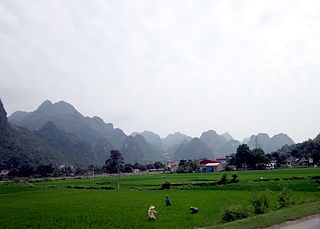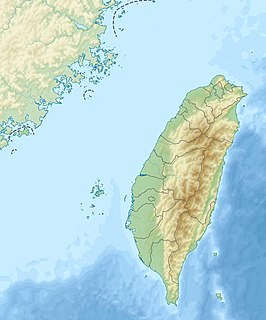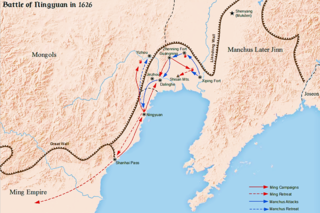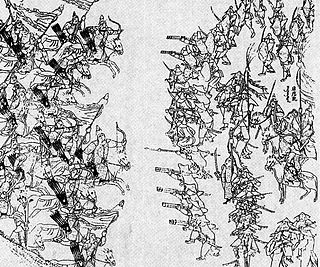 W
WThe Battle of Chi Lăng Pass was a short skirmish between Vietnamese force under Prince Lê Lợi and Chinese Ming dynasty army under General Liu Sheng. The battle took place in the Chi Lăng valley, Chi Lăng District, Northeast Vietnam on September 18, 1427. At first, the Vietnamese pretended to flee, leading the charging Chinese cavalry into the marshes near Dao Ma Pha mountain where Chinese horses were bogged down, ambushed, and slaughtered.
 W
WThe Battle of Buir Lake was fought between the Ming dynasty and the Northern Yuan dynasty at Buir Lake in 1388. The Ming army was led by General Lan Yu, who undertook the military campaign against Uskhal Khan, the Northern Yuan ruler. The Ming army defeated the Northern Yuan horde at Buir Lake, capturing many of their people.
 W
WThe Battle of Fort Zhenjiang was a military conflict between the Later Jin and the Ming dynasty. In the fall of 1621 Ming general Mao Wenlong captured Fort Zhenjiang on the border of the Jin-Joseon border and held it against multiple Jin assaults before retreating. Nurhaci burnt down the fort afterwards rather than risk having it captured again.
 W
WThe Battle of Fushun was the first military conflict in the war between the Jurchen-led Later Jin and the Ming dynasty. The battle ended in a decisive victory for the Later Jin and resulted in the capture of Fushun and two other nearby fortresses.
 W
WThe Battle of Guanging was a military conflict between the Later Jin dynasty and the Ming dynasty in 1622. It occurred at and around the Ming's northern city of Guangning, which fell to the Later Jin in 1622.
 W
WThe Battle of Kaiyuan was a conflict between the Later Jin and Ming dynasty in the summer of 1619. Following the victory at the Battle of Sarhu, Nurhaci continued the attack on Ming by assaulting the city of Kaiyuan.
 W
WThe Battle of Liaoluo Bay took place in 1633 off the coast of Fujian, China; involving the Dutch East India Company (VOC) and the Chinese Ming dynasty's navies. The battle was fought at the crescent-shaped Liaoluo Bay that forms the southern coast of the island of Kinmen. A Dutch fleet under Admiral Hans Putmans was attempting to control shipping in the Taiwan Strait, while the southern Fujian sea traffic and trade was protected by a fleet under Brigadier General Zheng Zhilong. This was the largest naval encounter between Chinese and European forces before the Opium Wars two hundred years later.
 W
WThe Battle of Ning-Jin was a military conflict between the Later Jin and Ming dynasty. In the spring of 1627, the Later Jin khan Hong Taiji invaded Ming territory in Liaoning under the pretext of illegal construction on Later Jin lands.
 W
WThe Battle of Ningyuan was a battle between the Ming dynasty and the Later Jin dynasty in 1626. The Later Jin had been waging war on the Ming for several years, and their leader Nurhaci had deemed Ningyuan to be a suitable target for his attack, in part due to advice from a Ming defector, Li Yongfang. Later Jin failed to take the city and Nurhaci was wounded in the assault, dying eight months later. The Ming emerged victorious, marking a temporary resurgence of the Ming army after an eight-year-long series of defeats.
 W
WThe Battle of Sarhū refers to a series of battles between the Later Jin dynasty and the Ming dynasty and their Joseon allies in the winter of 1619. The battle is notable for the heavy use of cavalry by the Later Jin in defeating Ming and Joseon forces equipped with hand cannons, cannons, and matchlocks.
 W
WThe Battle of Shen-Liao was a military conflict between the Later Jin and the Ming dynasty. In early 1621 Nurhaci, khan of the Later Jin, invaded Liaodong and captured the cities of Shenyang and Liaoyang from the Ming.
 W
WThe siege of Fort Zeelandia of 1661–1662 ended the Dutch East India Company's rule over Taiwan and began the Kingdom of Tungning's rule over the island.
 W
WThe Battle of Tốt Động – Chúc Động (1426) was the decisive battle in the 14-year Lam Sơn uprising which established Vietnam's independence from Ming China in 1428. The battle took place on 4 December 1426 in the Red River Delta between Tốt Động and Chúc Động, two villages of Chương Mỹ District, near Hanoi. Armed with hand cannons, the Vietnamese force of 3,000-men under Lê Lợi, the Prince of Pacific, was able to stage a successful ambush on the attacking Ming army under General Wang Tong. The Ming army was routed. At a result, most of Chinese weapons, supplies, and horses were captured by the Vietnamese. Wang Tong was forced to retreated back to Hanoi, where four days later he and the city were besieged by Le Loi's army.
 W
WThe Tumu Crisis, was a frontier conflict between the Northern Yuan dynasty and the Ming dynasty. The Oirat ruler of the Northern Yuan, Esen Taishi, captured the Emperor Yingzong of Ming on September 1, 1449.
 W
WThe Battle of Xicheng was a military conflict between the Yehe Jurchens, their Ming allies, and the Later Jin. In the fall of 1619 Nurhaci invaded Xicheng, the home of the Yehe Jurchens. Nurhaci personally led the vanguard and took the east wall. After capturing the city the Yehe inhabitants were spared, but their Ming allies who had fought beside them were executed.